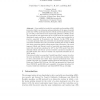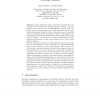FSE
2003
Springer
14 years 11 months ago
2003
Springer
In this paper, we present One-key CBC MAC (OMAC) and prove its security for arbitrary length messages. OMAC takes only one key, K (k bits) of a block cipher E. Previously, XCBC req...
EUROCRYPT
2003
Springer
14 years 11 months ago
2003
Springer
A new public-key model for resettable zero-knowledge (rZK) protocols, which is an extension and generalization of the upper-bounded public-key (UPK) model introduced by Micali and ...
EUROCRYPT
2003
Springer
14 years 11 months ago
2003
Springer
EUROCRYPT
2003
Springer
14 years 11 months ago
2003
Springer
Abstract. Recently, methods from provable security, that had been developped for the last twenty years within the research community, have been extensively used to support emerging...
EUROCRYPT
2003
Springer
14 years 11 months ago
2003
Springer
Perfectly secret message transmission can be realized with only partially secret and weakly correlated information shared by the parties as soon as this information allows for the ...
EUROCRYPT
2003
Springer
14 years 11 months ago
2003
Springer
EUROCRYPT
2003
Springer
14 years 11 months ago
2003
Springer
Abstract Benny Pinkas HP Labs Abstract. We demonstrate a transformation of Yao’s protocol for secure two-party computation to a fair protocol in which neither party gains any sub...
EUROCRYPT
2003
Springer
14 years 11 months ago
2003
Springer
Abstract. In this paper we present a simpler construction of a publickey encryption scheme that achieves adaptive chosen ciphertext security (CCA2), assuming the existence of trapd...
EUROCRYPT
2003
Springer
14 years 11 months ago
2003
Springer
At CRYPTO 2000, a new public-key encryption based on braid groups was introduced. This paper demonstrates how to solve its underlying problem using the Burau representation. By thi...
EUROCRYPT
2003
Springer
14 years 11 months ago
2003
Springer
Abstract. Digital Signatures emerge naturally from Public-Key Encryption based on trapdoor permutations, and the “duality” of the two primitives was noted as early as Diffie-He...






